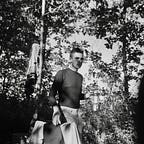Code as Art, Artists who Code
It often kept me awake into the early morning.
A blog I adored cataloguing images on as a teenager. I’d get so into perfecting the method of display on its landing page — editing available HTML/CSS templates — that finally I committed myself to coding a template myself. Soothing my sleepy eyes by the balm of my laptop’s light, I tried learning the platform’s APIs in a single night, determined to create the thing in its entirety.
From what I remember, the end result was pretty bad.
Every piece of text on my blog was rendered quite small and in Tahoma(?). The content’s wrapper was positioned in such a way that any movement of the window caused it to fall off the page(!). Code would peak out from the structure and appear in the body inexplicably.
By the time things felt functional, it was 7am.
Fast forward many years: it’s 2015. I’m pursuing a studio arts Bachelor’s degree. I’m still in the habit of working creatively through the night. I start making portfolio websites for my friends on request. Surely my form is a bit sloppy, but I enjoy coding and feel OK at it. In my lectures, I learn about the net.art movement — art collectives like JODI, who challenge familiar GUIs through poetic software manipulation — and the Post-Internet movement, a broad category of work that encompasses within it practices like Damon Zucconi’s, whose coding pursuits wax existential and poetic in a gallery context.
The worlds of software engineering and contemporary art, despite these obvious precedents, did not yet connect for me personally.
And so for a while after graduation, I worked strictly in the art world. I worked in galleries, for magazines and artist-run centres. I loved the work of facilitating art — loved working with artists especially — but it was financially inconsistent and, frankly, a bit boring.
Artists are often so committed to maintaining allegiance to the industry of art, that they fail to see the merit in exploring avocations in tandem. The pandemic was a reckoning for many. For me, as my gallery work dried up, it demanded I question once more, how I’d like to be spending my bankable time outside the studio. After speaking with a close friend on my roof one night, she reminded me
that I code.
that there are artists who code.
that code can be a language art, a design tool, a medium,
an entirely dynamic career.
And thus began my journey to professionalizing my capacity to code through Juno College. I took a part-time course while working as an exterminator over the summer, and am now in Juno’s Web Dev Immersive.
I anticipate more sleepless nights to come.
